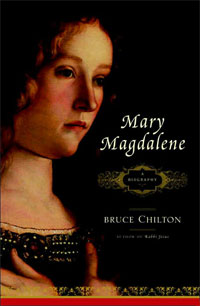Book Notes
 Bruce Chilton, Mary Magdalene; A Biography (New York: Doubleday, 2005), 220pp.
Bruce Chilton, Mary Magdalene; A Biography (New York: Doubleday, 2005), 220pp.
Jaroslav Pelikan once observed the predicament of the believing historian who must scrutinize the Biblical text with all the rigor demanded by his discipline, but do so in a way that does not suppress or undermine vibrant faith. He likened the task to doing brain surgery on your mother. Chilton's effort to elucidate the memory of Mary reads more like reconstructive cosmetic surgery.
He admits the paucity of his material, that what we know about Mary from the Gospels amounts to no more than "scraps." That is not unusual, of course; we know precious little about many figures in the Bible. But if you reject "the final form of the text" as Chilton does, and must search beyond and behind the text, then a crucial distinction emerges between reasonable inferences and wild speculation. To his credit, Chilton repeatedly warns about such conjectural reconstructions that are little more than exercises in wishful thinking, projection, fantasy, and folklore, whether they originate in modern scholarship or medieval legend.
Chilton wants to restore Mary to her privileged position as the most influential woman in the Jesus movement, the "apostle to the apostles." Specifically, he believes that she had a threefold ministry of exorcism (recall that Jesus healed her of seven demons in Luke 8:2–3), sacramental anointing, and vision or wisdom as the first witness of the resurrection. As he reads the Gospels and subsequent tradition, though, men (especially Matthew and Luke) repressed, manipulated, marginalized, brutally suppressed, resented, and displaced (all his words) the Magdalene tradition and her ministry. He proposes to recover it for us, but the problem with such salvage operations, as so many have observed, is that it is almost impossible for the historian not to project his own image onto the sources. Further, the quest to tease out the "original" Mary from the corrupted sources assumes that the reconstructed "original" will be more comprehensible to us, but I think that Romano Guardini was correct when he observed that the original, if it were possible to recover it, might appear less and not more comprehensible (cf. Garry Wills, What Jesus Meant). Finally, it is a mystery to me how Chilton can impugn not just the mistakes he thinks the Gospel writers made, but their horribly misogynous motives.
Alas, if only Chilton had heeded his own advice: "If we want to get at the truth about Mary, we need to examine what we know, not invent what we don't know, and refrain from dressing up yesterday's piety as today's revisionism." At the end of the day, Pelikan insisted, the historian always remains the object rather the subject in his encounter with the word of the Bible. Chilton reversed these roles and so missed an opportunity to say something good about someone truly important.


